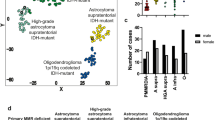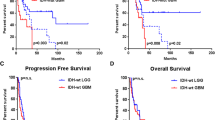Abstract
The mismatch repair genes, hMLH1 (3p22) and hMSH2 (2p21), are commonly associated with accumulation of mutations and microsatellite instability. However, the status of their gene loci itself is often not addressed. In astrocytic tumors, the heterozygosity status of these genes with reference to tumor grade has not yet been determined. We have analyzed the heterozygosity status and locus specific instability in 43 glial tumors comprising 22 low grades diffuses astrocytoma (WHO Grade II, DA) and 21 glioblastoma multiforme (Grade IV GBM) using 10 microsatellite markers at 2p and 3p to elucidate the involvement of these loci in astrocytic tumorigenesis. We observed a significantly higher loss of heterozygosity (LOH) in 3p markers encompassing the hMLH1 gene locus in DA when compared to GBM (P = 0.008). In DA, while the frequency of LOH was observed to be higher in markers close to the hMLH1 gene (∼40%), locus specific microsatellite instability (LSI) was higher (∼30%) in markers localizing further to the gene. The frequency of LOH at markers on 2p, near the hMSH2 gene was, however, similar in DA and GBM (P = 0.451). Our results suggest that in the astrocytic tumorigenesis, LOH at the hMLH1 gene locus is an early event in tumorigenesis. However, the mismatch repair protein expression may be regulated by other cellular factors.



Similar content being viewed by others
References
Maher EA, Furnari FB, Bachoo RM et al. (2001) Malignant glioma: genetics and biology of a grave matter. Genes Dev 15:1311–1333
Chattopadhyay P, Rathore A, Mathur M et al. (1997) Loss of heterozygosity of a locus on 17p13.3, independent of p53, is associated with higher grades of astrocytic tumours. Oncogene 15:871–874
Sarkar C, Chattopadhyay P, Ralte AM et al. (2003) Loss of heterozygosity of a locus in the chromosomal region 17p13.3 is associated with increased cell proliferation in astrocytic tumors. Cancer Genet Cytogenet 144:156–164
Wang Y, Friedl W, Lamberti C et al. (2003) Hereditary nonpolyposis colorectal cancer: frequent occurrence of large genomic deletions in MSH2 and MLH1 genes. Int J Cancer 103:636–641
Thibodeau SN, French AJ, Roche PC et al. (1996) Altered expression of hMSH2 and hMLH1 in tumors with microsatellite instability and genetic alterations in mismatch repair genes. Cancer Res 56:4836–4840
Srivastava T, Chattopadhyay P, Mahapatra AK et al. (2004) Increased hMSH2 protein expression in glioblastoma multiforme. J Neurooncol 66:51–57
Fink D, Aebi S, Howell SB (1998) The role of DNA mismatch repair in drug resistance. Clin Cancer Res 4:1–6
Maitra A, Wistuba II, Washington C et al. (2001) High-resolution chromosome 3p allelotyping of breast carcinomas and precursor lesions demonstrates frequent loss of heterozygosity and a discontinuous pattern of allele loss. Am J Pathol 159:119–130
Zabarovsky ER, Lerman MI, Minna JD (2002) Tumor suppressor genes on chromosome 3p involved in the pathogenesis of lung and other cancers. Oncogene 21:6915–6935
Mora J, Cheung NK, Oplanich S et al. (2002) Novel regions of allelic imbalance identified by genome-wide analysis of neuroblastoma. Cancer Res 62:1761–1767
Tada T, Watanabe T, Kanazawa T et al. (2004) Genetic characterization of colorectal cancers in young patients based on chromosomal loss and microsatellite instability. Scand J Gastroenterol 39:1134–1140
Krupp W, Geiger K, Schober R et al. (2004) Cytogenetic and molecular cytogenetic analyses in diffuse astrocytomas. Cancer Genet Cytogenet 153:32–38
Alonso M, Hamelin R, Kim M et al. (2001) Microsatellite instability occurs in distinct subtypes of pediatric but not adult central nervous system tumors. Cancer Res 61:2124–2128
Gomori E, Fulop Z, Meszaros I et al. (2002) Microsatellite analysis of primary and recurrent glial tumors suggests different modalities of clonal evolution of tumor cells. J Neuropathol Exp Neurol 61:396–402
Leung SY, Yuen ST, Chan TL et al. (2000) Chromosomal instability and p53 inactivation are required for genesis of glioblastoma but not for colorectal cancer in patients with germline mismatch repair gene mutation. Oncogene 19:4079–4083
Martinez R, Schackert HK, Appelt H et al. (2005) Low level microsatellite instability phenotype in sporadic glioblastoma multiforme. J Cancer Res Clin Oncol 131:87–93
Misra A, Chattopadhyay P, Dinda AK et al. (2000) Extensive intra-tumor heterogeneity in primary human glial tumors as a result of locus non-specific genomic alterations. J Neurooncol 48:1–12
Tomlinson IPM, Ilyas M, Bodmer WF (1996) Allele loss occurs frequently at hMLH1, but rarely at hMSH2, in sporadic colorectal cancers with microsatellite instability. Br J Cancer 74:1514–1517
Balmain A, Gray J, Ponder B (2003). The genetics and genomics of cancer. Nat Genet 33:238–244
Kanno H, Shuin T, Kondo K, Yamamoto I, Ito S, Shinonaga M, Yoshida M, Yao M (1997) Somatic mutations of the von Hippel-Lindau tumor suppressor gene and loss of heterozygosity on chromosome 3p in human glial tumors. Cancer Res 57:1035–1038
Onuki N, Wistuba II, Travis WD et al. (1999). Genetic changes in the spectrum of neuroendocrine lung tumors. Cancer 85:600–607
Knuutila S, Aalto Y, Autio K et al. (1999) DNA copy number losses in human neoplasms. Am J Pathol 155:683–694
Woenckhaus C, Fenic I, Giebel J et al. (2004) Loss of heterozygosity at 12p13 and loss of p27KIP1 protein expression contribute to melanoma progression. Virchows Arch 445:491–497
Gunduz E, Gunduz M, Ouchida M et al. (2005) Genetic and epigenetic alterations of BRG1 promote oral cancer development. Int J Oncol 26:201–210
Rellecke P, Kuchelmeister K, Schachenmayr W et al. (2004). Mismatch repair protein hMSH2 in primary drug resistance in vitro human malignant gliomas. J Neurosurg 101:653–658
Szybka M, Bartkowiak J, Zakrzewski K et al. (2003) Microsatellite instability and expression of DNA mismatch repair genes in malignant astrocytic tumors from adult and pediatric patients. Clin Neuropathol 22:180–186
Yu J, Zhang H, Gu J et al. (2004) Methylation profiles of thirty four promoter-CpG islands and concordant methylation behaviours of sixteen genes that may contribute to carcinogenesis of astrocytoma. BMC Cancer 4:65
Fukushima T, Katayama Y, Watanabe T et al. (2005) Promoter hypermethylation of mismatch repair gene hMLH1 predicts the clinical response of malignant astrocytomas to nitrosourea. Clin Cancer Res 11:1539–1544
Wang Y, Cortez D, Yazdi P et al. (2000) BASC, a super complex of BRCA1-associated proteins involved in the recognition and repair of aberrant DNA structures. Genes Dev 14:927–939
Smith JA, Waldman BC, Waldman AS (2005) A role for DNA mismatch repair protein msh2 in error-prone double-strand-break repair in mammalian chromosomes. Genetics 170:355–363
Xinarianos G, Liloglou T, Prime W et al. (2002) p53 status correlates with the differential expression of the DNA mismatch repair protein MSH2 in non-small cell lung carcinoma. Int J Cancer 101:248–252
Gorlov IP, Gorlova OY, Frazier ML et al. (2003) Missense mutations in hMLH1 and hMSH2 are associated with exonic splicing enhancers. Am J Hum Genet 73:1157–1161
Loeb LA, Loeb KR, Anderson JP (2003) Multiple mutations and cancer. Proc Natl Acad Sci USA 100:776–781
Acknowledgements
We gratefully acknowledge Mathura Prasad and Rajesh for technical help and Satish for secretarial work. Tapasya Srivastava was a CSIR Senior Research Fellow and is currently a recipient of Young Scientist Fellowship from Department of Science and Technology. This work was supported by a Swarnjayanti Fellowship grant from Department of Science and Technology, India to Subrata Sinha.
Author information
Authors and Affiliations
Corresponding author
Rights and permissions
About this article
Cite this article
Srivastava, T., Chosdol, K., Chattopadhayay, P. et al. Frequent loss of heterozygosity encompassing the hMLH1 locus in low grade astrocytic tumors. J Neurooncol 81, 249–255 (2007). https://doi.org/10.1007/s11060-006-9230-1
Received:
Accepted:
Published:
Issue Date:
DOI: https://doi.org/10.1007/s11060-006-9230-1




